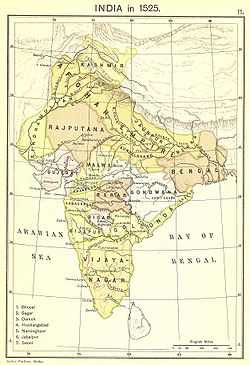Sultanate of Sindh | |||||||||||||
|---|---|---|---|---|---|---|---|---|---|---|---|---|---|
| 1351–1593 | |||||||||||||
 Sindh Sultanate in 1525 alongside Multan Sultanate | |||||||||||||
| Status | Sultanate | ||||||||||||
| Capital | Thatta (1352–1374; 1389–1593) Samui (1374–1389) Bhakkar (1522–1554)[a] | ||||||||||||
| Largest city | Thatta | ||||||||||||
| Common languages | Persian (Official) Sindhi (Native) Kutchi Gujarati Arabic Balochi Saraiki | ||||||||||||
| Religion | State religion: Sunni Islam (Shafi'i) (1351–1524) Sunni Islam (Hanafi) (1520–1593) Others: Hinduism Buddhism | ||||||||||||
| Demonym(s) | Sindhi | ||||||||||||
| Government | Absolute monarchy | ||||||||||||
| Sultan | |||||||||||||
• 1351–1352 (first) | Firuz'ud-Din Unar | ||||||||||||
• 1585–1593 (last) | Jani Beg Tarkhan | ||||||||||||
| Historical era | Medieval India | ||||||||||||
• Jam Unar defeats Sardar Hamir | 1351 | ||||||||||||
• Delhi–Sindh War | 1350–1368 | ||||||||||||
• Samma–Soomra War | 1351–1352 | ||||||||||||
• Sindh–Gujarat Alliance | 1442 | ||||||||||||
• Arghun–Samma War | November 1518–October 1524 | ||||||||||||
• Sindh–Multan War | 1525–1527 | ||||||||||||
• Mughal–Sindh War | 1586–1 November 1592 | ||||||||||||
• Abdication of Jani Beg Tarkhan | 28 March 1593 | ||||||||||||
| Area | |||||||||||||
| 1470 | 160,211 km2 (61,858 sq mi) | ||||||||||||
| Currency | Gold Dinar Silver Tanka Copper Jital Bronze Falus | ||||||||||||
| |||||||||||||
| Today part of | |||||||||||||
The Sindh Sultanate (Sindhi: سنڌ جي سلطنت, Persian: سلطان نشین سند) or historically romanized as Sultanate of Sind, was a medieval Indo-Islamic sultanate established in the mid 14th century primarily based in Sindh and some parts of Gujarat and Punjab. Following the defeat of Soomra Emirate by the Sammas, three dynasties ruled over the Sindh Sultanate sequentially: the Samma dynasty (1351–1524), the Arghun dynasty (1520–1554), and the Tarkhan dynasty (1554–1593).
The Sindh Sultanate controlled large parts of Derajat, Kutch, and Lasbela along with the entirety of Sindh itself. It reached its zenith under Jam Nizam'ud-Din II, who worked beside Sultan Mahmud Begada to establish peace and prosperity in the region.[1] The Sultanate was run by Sindhi, Jat, Rajput, Turco-Mongol, Turco-Persian, and Gujarati elites and nobles. Sindh before the Sammas was administered by the Soomras as a vassal state of the Fatimids and then of the Abbasids and Delhiites. During the reign of the Sammas, Thatta thrived into India's one of the most economically and systematically powerful cities of that time. Sindh was a major hub for the influential teachings of the Isma'ili missionaries (Da'is) and Sunni saints (Shaykhs).[2] The Sultans themselves adopted many rituals of the religious leaders and allowed them to openly preach their message to the masses. The early Samma Jams ruled from Samui but moved to Thatta after its dignification. The Arghuns, on the other hand, ruled the Lower Sindh from Thatta while the Upper Sindh from Bhakkar. Thatta, together with Bhakkar and Sehwan, were the only mint cities and major commercial and residential districts of the Sultanate. Persian was exercised upon as the court and state language as well as the lingo of the elites while Sindhi and Kutchi were used by the commoners.[3] For the majority of its timespan, the Sultanate had great political and traditional ties with other countries like Gujarat, Kashmir, Bengal, Punjab, Delhi, and the Deccan sultanates. These interrelations resulted in the establishment of interconnected trade and businesses.[4]
Cite error: There are <ref group=lower-alpha> tags or {{efn}} templates on this page, but the references will not show without a {{reflist|group=lower-alpha}} template or {{notelist}} template (see the help page).
- ^ Hughes, A. W. (Albert William) (1874). A gazetteer of the province of Sindh. Oxford University. London : G. Bell and Sons.
- ^ "A History of Sindh". Goodreads. Retrieved 8 April 2024.
- ^ "HISTORY OF SINDHI LITERATURE". Vanguard Books. Retrieved 8 April 2024.
- ^ Ahmed, Fouzia Farooq (30 November 2016). Muslim Rule in Medieval India: Power and Religion in the Delhi Sultanate. London New York: I.B. Tauris. ISBN 978-1-78453-550-6.
© MMXXIII Rich X Search. We shall prevail. All rights reserved. Rich X Search
